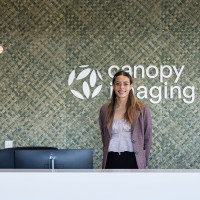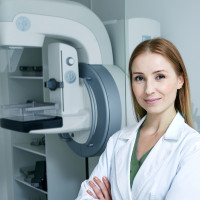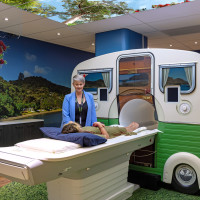
Bowel Cancer Awareness Month: Screening with a CT Colonography
If you are considering bowel cancer screening or have been referred for further investigation, you may be offered a test called CT colonography. Also known as virtual colonoscopy, this advanced imaging procedure uses computed tomography (CT) technology to produce detailed views of the colon and rectum. It can identify polyps, tumours, and other abnormalities in the bowel.
At Canopy Imaging, we want you to feel informed, prepared, and confident about your care. This guide explains CT colonography and what to expect before, during, and after your scan.
What is CT colonography?
CT colonography is a non-invasive imaging test that uses CT technology to produce detailed, three-dimensional images of the inside of the colon and rectum. Unlike traditional colonoscopy, which involves inserting a long flexible tube with a camera into the colon, CT colonography uses X-rays and computer software to construct internal views.
Why is CT colonography performed?
CT colonography is mainly used to check for polyps and cancers in the colon and rectum. It’s recognized as an effective screening option for bowel cancer and may be recommended as an alternative to colonoscopy for people who are older, frail, or have health conditions that make conventional colonoscopy more challenging.
Bowel cancer screening in New Zealand
Bowel cancer (also called colorectal cancer) refers to cancer that starts in the colon or rectum. New Zealand has one of the highest rates of bowel cancer in the developed world, and it is the country’s second most common cause of cancer-related death.
Early detection through bowel cancer screening significantly improves the chances of successful treatment. People diagnosed and treated when bowel cancer is at an early stage have a 90 percent chance of long-term survival. Bowel cancer screening can also detect polyps, which are small growths in the lining of the bowel that may develop into cancer over time. These can easily be removed to prevent cancer developing.
The National Bowel Screening Programme (NBSP) currently offers free faecal immunochemical testing (FIT) every 2 years to eligible people aged 60 to 74 years. The starting age is expected to be lowered to 58 in the near future. FIT is a non-invasive test performed on a sample of your stool. If the result is positive, you will be referred for a colonoscopy or a CT colonography.
While New Zealand’s publicly funded programme plays a key role in reducing bowel cancer deaths, many international guidelines recommend starting screening at a younger age and provide a broader range of screening options.
Leading international organisations, including the United States Preventive Services Task Force, the American Cancer Society, and the American College of Gastroenterology, recommend starting routine bowel cancer screening from age 45, reflecting the increasing rates of bowel cancer in younger adults.
These guidelines endorse a range of acceptable screening options, including a colonoscopy every 10 years, a faecal immunochemical test (FIT), every 1 or 2 years, or a CT colonography every 5 years.
These recommendations apply to patients who have no bowel symptoms and are not known to be at increased risk for bowel cancer. Speak to your doctor if you would like more information or a referral for screening that is not part of the publicly funded programme.
If you have a higher risk for bowel cancer you may need earlier or more frequent screening. Discuss with your doctor if you have any of the following risk factors:
- Strong family history of bowel cancer
- Past history of bowel cancer or sessile serrated polyps
- Inflammatory bowel disease (ulcerative colitis or Crohn disease)
- Cystic fibrosis
- History of childhood, adolescent, or young adult cancer treated with radiation therapy or chemotherapy
Benefits and limitations of CT colonography
Advantages:
- Non-Invasive and safe: Does not require insertion of a colonoscope, so there is no discomfort and much lower risk of complications such as bowel perforation
- Quick: The procedure is faster than a traditional colonoscopy. The appointment takes about 45 minutes
- Comprehensive: Provides detailed images of the entire colon and rectum
- No sedation or pain relief is required: You can return to your normal activities immediately after the scan
- Provides images of other abdominal organs: May detect abnormalities in liver, kidneys, and other organs in the abdomen
Limitations and risks:
- Missed Polyps: Smaller polyps or flat lesions may not be detected as easily as with a traditional colonoscopy
- Additional procedure may be required: If the scan detects abnormalities requiring further investigation, or a polyp requiring removal, a colonoscopy will need to be performed
- Radiation Exposure: While the radiation dose is low, this may be a consideration for some patients
- Bowel perforation (very rare): The risk of bowel perforation due to inflation of the colon with air is extremely low (fewer than 1 in 10000 people)
Preparing for CT colonography
To obtain the most accurate images, the bowel must be thoroughly cleansed. You will be asked to follow a clear liquid diet for 2 days before the test. This includes water, clear broths, and certain juices. You will also be prescribed a laxative to take the day before to empty the bowel.
During the scan
You will change into a hospital gown and remove any metal objects or jewelry. You will have an intravenous (IV) cannula inserted in your arm, and an injection of muscle relaxant (Buscopan) will be given to relax the bowel and reduce cramping.
A small flexible plastic tube will be placed into your rectum to gently inflate your colon with air to improve visibility on the scan. You will likely feel a fullness as if you need to pass wind when the colon is filled with air, but you must try to hold it in.
Two CT scans are performed, one where you are positioned on your back, and another lying on your stomach. Once the scans are completed, the rectal tube is removed and you will be shown to the bathroom.
After the scan
You will change back into your clothes and remain to be monitored for around 10 minutes. There is no recovery period and you can resume your normal diet and activities. You may have some mild cramping for a few hours afterwards.
A radiologist will interpret your scan and the results will be sent to your doctor.
Where can I get a CT colonography at Canopy Imaging?
View our locations here.
















